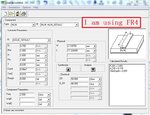tomato_sos
Junior Member level 3

Hi all,
I am new in designing microwave amplifier. Just get started only.
I am currently doing a microwave amplifier designing project.
I am using ATF-55143 from AVAGO.
My design is at 2.5 GHz. After calculate the stability, the \Delta <1, K<1, even the \mu <1.
How to determine whether it is stable or not ?
Anyone have other suggestion on the transistor?
I was thinking AT-32032, but it is discontinued.
I am new in designing microwave amplifier. Just get started only.
I am currently doing a microwave amplifier designing project.
I am using ATF-55143 from AVAGO.
My design is at 2.5 GHz. After calculate the stability, the \Delta <1, K<1, even the \mu <1.
How to determine whether it is stable or not ?
Anyone have other suggestion on the transistor?
I was thinking AT-32032, but it is discontinued.






